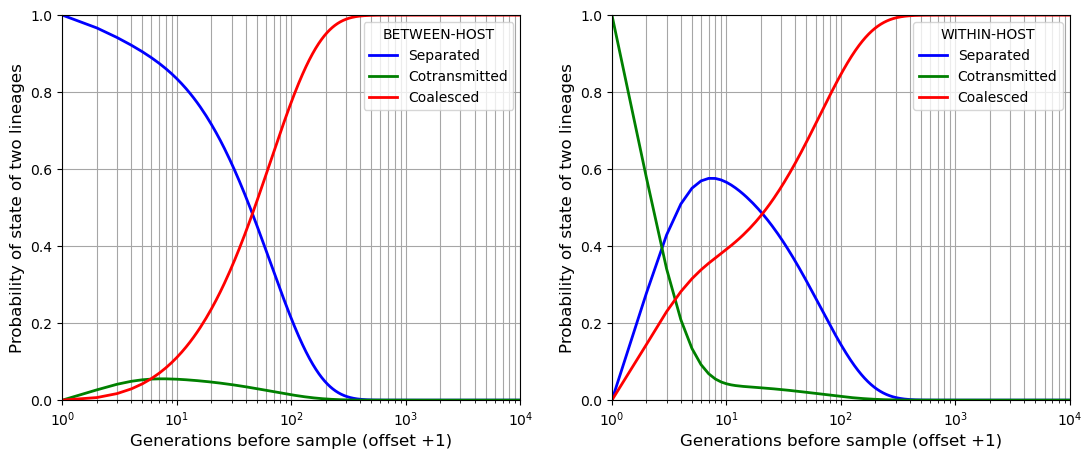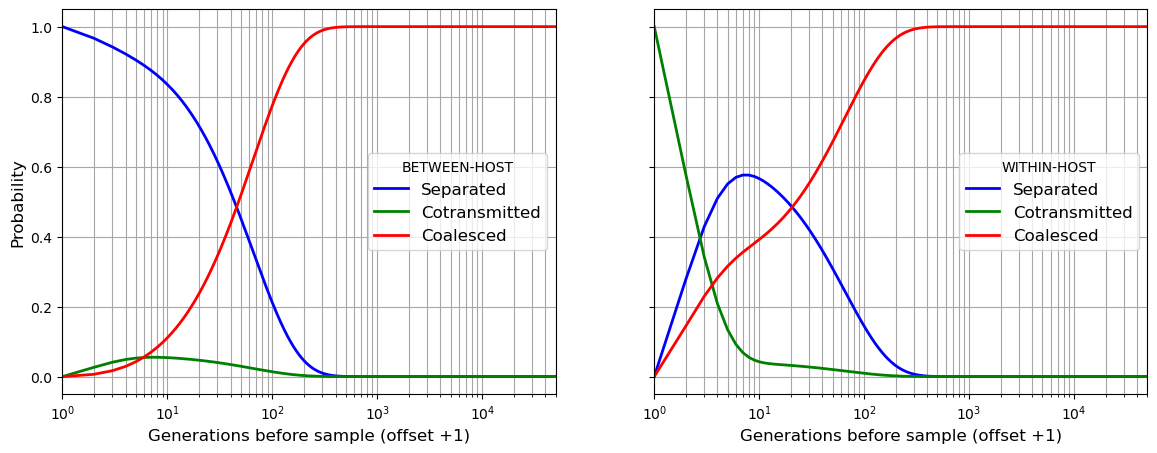Time to coalescence#
If we sample two alleles at a point locus and follow their lineages back in time through the generations, at any point in time they must be in one of three states:
SEPARATED - the two lineages are in different hosts
COTRANSMITTED - the two lineages are in the same host
COALESCED
With the genomic transmission graph, we can work out a matrix of transition probabilities between these three states. Using this we can perform a Markov chain simulation that gives us the probability distribution of time to coalescence.
We start by specifying the transmission parameters and the duration of the simulation
Nis the effective number of hostsXis the crossing rate of transmission chainsQis the quantum of transmissiont_simis the duration of the simulation in generations
We use the transmission parameters to construct a matrix of transition probabilities called transition_matrix.
We create arrays to record the state of two lineages as we progress back in time
beho_lineageandwiho_lineageare two-dimensional arrays that record a probability vector [Pr{SEPARATED}, Pr{COTRANSMITTED}, Pr{COALESCED}] for each time point.beho_lineagestudies between-host variation so we specify that Pr{SEPARATED} = 1 at the start of the simulation, i.e. we sample two alleles from different hosts.wiho_lineagestudies within-host variation so we specify that Pr{COTRANSMITTED} = 1 at the start of the simulation, i.e. we sample two alleles from the same host.
We work out the probability vector for each successive time point by matrix multiplication then we plot the results.
We create an array called tcdist that records the probability of coalescence occurring at each time point, and from this we can calculate the mean time to coalescence.
import numpy as np
import matplotlib.pyplot as plt
# SPECIFY THE TRANSMISSION PARAMETERS
N = 30 # Effective number of hosts.
X = 0.5 # Crossing rate of transmission chains
Q = 5 # Quantum of transmission.
# SPECIFY THE DURATION OF THE SIMULATION IN GENERATIONS
t_sim = 10000
# CREATE A MATRIX OF TRANSITION PROBABILITIES
transition_matrix = np.ones((3,3))
transition_matrix[0,:] = [1 - (1 / N),
(Q - 1) / (N * Q),
1 / (N * Q)]
transition_matrix[1,:] = [Q * X / (2*Q - 1),
(Q - 1) * (2*Q - Q*X - 1) / (Q * (2*Q - 1)),
(2*Q - Q*X - 1) / (Q * (2*Q - 1))]
transition_matrix[2,:] = [0, 0, 1]
# CREATE ARRAYS TO TRACK THE STATE OF TWO LINEAGES AS WE PROGRESS BACK IN TIME
beho_lineage = np.zeros((t_sim + 1, 3)) # an array for analysing between-host variation
wiho_lineage = np.zeros((t_sim + 1, 3)) # an array for analysing within-host variation
# [t,0] Pr{Separated} at time t
# [t,1] Pr{Cotransmitted}
# [t,2] Pr{Coalesced}
# To study between-host variation we specify that at t=0 the lineages are separated
beho_lineage[0,:] = [1, 0, 0]
# To study within-host variation we specify that at t=0 the lineages are cotransmitted
wiho_lineage[0,:] = [0, 1, 0]
# PERFORM THE SIMULATION BY MATRIX MULTIPLICATION
for t in range(1, t_sim + 1):
beho_lineage[t,:] = np.matmul(beho_lineage[t-1,:], transition_matrix[:,:])
wiho_lineage[t,:] = np.matmul(wiho_lineage[t-1,:], transition_matrix[:,:])
# DISPLAY THE PROBABILITY OF EACH STATE OVER TIME
# To allow log scale for time we offset the horizontal axis by +1. Thus t=1 is the time of sampling alleles.
plt.figure(figsize=(13,5))
plt.subplot(1,2,1)
plt.plot(range(1,t_sim + 2), beho_lineage[:,0], marker='', color='blue', linewidth=2, label="Separated")
plt.plot(range(1,t_sim + 2), beho_lineage[:,1], marker='', color='green', linewidth=2, label="Cotransmitted")
plt.plot(range(1,t_sim + 2), beho_lineage[:,2], marker='', color='red', linewidth=2, label="Coalesced")
plt.xlabel("Generations before sample (offset +1)", fontsize=12)
plt.ylabel("Probability of state of two lineages", fontsize=12)
plt.xscale('log')
plt.grid(visible=True, which='both', color='0.65', linestyle='-')
plt.axis([1, t_sim, 0, 1])
plt.legend(title="BETWEEN-HOST", frameon=True) # can add (title="Title", frameon=False)
plt.subplot(1,2,2)
plt.plot(range(1,t_sim + 2), wiho_lineage[:,0], marker='', color='blue', linewidth=2, label="Separated")
plt.plot(range(1,t_sim + 2), wiho_lineage[:,1], marker='', color='green', linewidth=2, label="Cotransmitted")
plt.plot(range(1,t_sim + 2), wiho_lineage[:,2], marker='', color='red', linewidth=2, label="Coalesced")
plt.xlabel("Generations before sample (offset +1)", fontsize=12)
plt.ylabel("Probability of state of two lineages", fontsize=12)
plt.xscale('log')
plt.grid(visible=True, which='both', color='0.65', linestyle='-')
plt.axis([1, t_sim, 0, 1])
plt.legend(title="WITHIN-HOST", frameon=True) # can add (title="Title", frameon=False)
plt.show()

Having seen how the Markov chain simulation works, in the next cell we will perform exactly the same set of calculations using the get_coalescent() function within the coalestr package:
We create a population by invoking
coalestr.Population(). We supply the history of transmission parameters as an argument. In this case the transmission parameters are constant over time so the history is a simple list.We invoke
get_coalescent()for our population. This runs a Markov chain simulation and gives us the mean coalescence time. It also returns the two arrays described above,beho_lineageandwiho_lineage, as attributes of our population.We use these two arrays to plot the state of two lineages as we progress back in time
!pip install coalestr
from coalestr import cs
import matplotlib.pyplot as plt
N = 30 # Effective number of hosts
Q = 5 # Quantum of transmission
X = 0.5 # Crossing rate of transmission chains
duration = 50000
history = [[duration, N, Q, X, 0]]
my_population = cs.Population(history)
my_population.get_coalescent()
b_separated = my_population.beho_lineage[:, 0]
b_cotransmitted = my_population.beho_lineage[:, 1]
b_coalesced = my_population.beho_lineage[:, 2]
w_separated = my_population.wiho_lineage[:, 0]
w_cotransmitted = my_population.wiho_lineage[:, 1]
w_coalesced = my_population.wiho_lineage[:, 2]
# in this figure the time axis has a log scale
# .. which requires that we offset the axis by 1
# .. so we pretend that alleles are sampled at bt = 1
timescale = range(1, my_population.t_his + 1)
fig, (ax1, ax2) = plt.subplots(1, 2, figsize=(14,5), sharex = True, sharey = True)
ax1.plot(timescale, b_separated, marker='', color='blue', linewidth = 2, label="Separated")
ax1.plot(timescale, b_cotransmitted, marker='', color='green', linewidth = 2, label="Cotransmitted")
ax1.plot(timescale, b_coalesced, marker='', color='red', linewidth = 2, label="Coalesced")
ax2.plot(timescale, w_separated, marker='', color='blue', linewidth = 2, label="Separated")
ax2.plot(timescale, w_cotransmitted, marker='', color='green', linewidth = 2, label="Cotransmitted")
ax2.plot(timescale, w_coalesced, marker='', color='red', linewidth = 2, label="Coalesced")
ax1.legend(title="BETWEEN-HOST",frameon=True, fontsize=12)
ax2.legend(title="WITHIN-HOST",frameon=True, fontsize=12)
ax1.set_xlabel("Generations before sample (offset +1)", fontsize=12)
ax2.set_xlabel("Generations before sample (offset +1)", fontsize=12)
ax1.set_ylabel("Probability", fontsize=12)
ax1.set_xscale('log',base=10)
ax1.set_xlim(1,my_population.t_his)
ax1.grid(visible=True, which='both', color='0.65', linestyle='-')
ax2.grid(visible=True, which='both', color='0.65', linestyle='-')
plt.show()
Observation time. Events captured. Mean coalescence time
beho wiho beho wiho
0 100.0 100.0 67.3 46.7

In the cell below we plot the probability distribution of coalescence time for three different populations:
\(N_h = 100, Q = 1, \chi = 0\)
\(N_h = 100, Q = 2, \chi = 0.5\)
\(N_h = 100, Q = 10, \chi = 1\)
# Nh = 100, Q = 1, X = 0
history_1 = [[10000, 100, 1, 0, 0]]
pop_1 = cs.Population(history_1)
pop_1.get_coalescent(show = False)
# Nh = 100, Q = 2, X = 0.5
history_2 = [[10000, 100, 2, 0.5, 0]]
pop_2 = cs.Population(history_2)
pop_2.get_coalescent(show = False)
# Nh = 100, Q = 10, X = 1
history_3 = [[10000, 100, 10, 1, 0]]
pop_3 = cs.Population(history_3)
pop_3.get_coalescent(show = False)
ig, (ax1, ax2) = plt.subplots(1, 2, figsize=(12,4), sharex = True)
for example in [pop_1, pop_2, pop_3]:
N = example.parameters[0,0]
Q = example.parameters[0,1]
X = example.parameters[0,2]
timescale = range(1, example.t_his)
beho_coalescent = example.coalescent[0, 1:, 0]
wiho_coalescent = example.coalescent[0, 1:, 1]
ax1.plot(timescale, beho_coalescent, marker='', linewidth=2, label=
"N {0:.0f}, Q {1:.0f}, \u03C7 {2:.1f}".format(N, Q, X))
ax2.plot(timescale, wiho_coalescent, marker='', linewidth=2, label=
"N {0:.0f}, Q {1:.0f}, \u03C7 {2:.1f}".format(N, Q, X))
ax1.set_title("Between-host", position=(0.8, 0.3), fontsize=14)
ax2.set_title("Within-host", position=(0.8, 0.3), fontsize=14)
ax1.set_xlabel("Time to coalescence", fontsize=12)
ax2.set_xlabel("Time to coalescence", fontsize=12)
ax1.set_ylabel("Probability", fontsize=12)
ax1.set_xscale('log',base=10)
ax1.legend(frameon=False, fontsize=12)
ax2.legend(frameon=False, fontsize=12)
plt.show()


